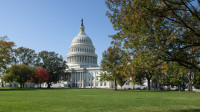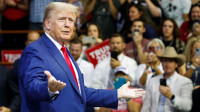
In This Article:
- What is the Powell Memo, and how did it influence politics?
- How did Clinton’s compromises align Democrats with neoliberalism?
- Did Obama’s policies continue the neoliberal agenda?
- Why did bond market fears under Clinton prove unfounded?
- How does Trump’s presidency highlight real economic risks today?
- What lessons can Democrats learn from FDR’s populist legacy?
How Clinton and Obama Gave Trump His Opening
by Robert Jennings, InnerSelf.com
In the early days of 1993, Bill Clinton stepped into the Oval Office with promises of a brighter future. The Democratic president, buoyed by the optimism of his campaign, spoke of universal healthcare, rebuilding America’s infrastructure, and easing the economic burdens of the middle class. Yet, just months into his presidency, that bold agenda began to unravel. Behind closed doors, Clinton faced mounting warnings from advisors and Federal Reserve officials. If he pursued his ambitious plans, they claimed, the bond market would revolt, driving up borrowing costs and destabilizing the economy. The message was clear: bold reforms were too risky. Clinton backed down.
But that revolt never came. Instead, what followed was a gradual alignment of the Democratic Party with neoliberal principles, shaped by the lingering influence of the Powell Memo—a corporate manifesto penned in 1971 that sought to curb government power and promote business dominance. This alignment, carried forward by Barack Obama’s presidency, set the stage for today’s stark inequalities and populist backlash. And now, as the bond market reacts to real threats posed by Trump’s economic policies, the echoes of past Democratic compromises reveal how manufactured fears paved the way for genuine risks.
The Powell Memo: A Blueprint for Corporate Power
The seeds of neoliberalism were planted long before Clinton entered the White House. In 1971, Lewis Powell, then a corporate lawyer and future Supreme Court justice, penned a confidential memo for the U.S. Chamber of Commerce. Titled “Attack on American Free Enterprise System,” it outlined a comprehensive strategy for businesses to reclaim influence over politics, media, and academia. Powell argued that corporate interests were under siege and urged business leaders to take an aggressive stance to shape public opinion and policy.
The Powell Memo wasn’t just a document; it was a playbook. Over the following decades, it inspired a wave of conservative think tanks, lobbying groups, and media campaigns. By the time Ronald Reagan took office in 1981, neoliberal principles—free markets, deregulation, and limited government—had become the dominant ideology. While Democrats initially resisted, the pressure to align with these ideas grew, particularly as corporate donors became critical to political campaigns.
Clinton and the Slippery Slope
When Clinton took office in 1993, he promised a new era of progressive leadership. His campaign had centered on the struggles of working Americans, and he had won over voters with his charisma and vision. But shortly after his inauguration, Clinton faced intense pressure from Wall Street and his own economic advisors. Figures like Treasury Secretary Robert Rubin and Federal Reserve Chairman Alan Greenspan warned that expansive government spending could spook the bond market, driving up interest rates and undermining economic stability.
Fearing a financial backlash, Clinton shifted priorities. Universal healthcare, championed by Hillary Clinton, was abandoned after fierce opposition from Republicans and industry groups. Instead, his administration pursued deficit reduction and fiscal discipline. Clinton signed the North American Free Trade Agreement (NAFTA), promoting free trade but devastating manufacturing communities. He reformed welfare, imposing strict work requirements and slashing federal aid. The repeal of the Glass-Steagall Act in 1999 dismantled Depression-era regulations that had separated commercial and investment banking, setting the stage for the 2008 financial crisis.
These policies reflected a broader alignment with neoliberalism, where market stability and corporate interests took precedence over systemic reform. Clinton’s compromises were framed as pragmatic, but they alienated working-class voters and widened economic inequality. And the bond market? It remained stable. The fears that had driven Clinton to pivot were never realized, raising the question: Were those warnings grounded in reality, or were they tools of corporate influence?
Obama’s Continuation of the Neoliberal Agenda
Barack Obama’s presidency began in the shadow of the Great Recession. Like Clinton, Obama entered office with a mandate for change, promising hope and renewal. But his approach to governance often mirrored Clinton’s cautious pragmatism. Faced with a collapsing financial system, Obama prioritized market stability over bold reform.
The Troubled Asset Relief Program (TARP), initiated under George W. Bush and expanded by Obama, funneled billions into bailing out banks while leaving homeowners to fend for themselves. The stimulus package—the American Recovery and Reinvestment Act—helped stave off deeper economic collapse, but it was insufficient to address the scale of the crisis. Critics argued that Obama undersold its benefits, failing to frame it as a moral and economic necessity.
The Affordable Care Act, while expanding healthcare access, preserved the dominance of private insurers, avoiding structural reform. Obama’s reluctance to confront Wall Street or embrace progressive rhetoric left many disillusioned. The Democratic Party’s alignment with neoliberalism remained intact, even as inequality deepened and working-class voters felt increasingly abandoned.
The Bond Market Reacts to Real Threats
Fast forward to today, and the bond market is no longer responding to manufactured fears. Under Trump’s presidency and the potential for his return, investors are facing genuine threats. The bond market, often seen as a barometer of economic stability, has reacted to Trump’s erratic policies and their inflationary potential. His tax cuts for the wealthy, trade wars, and ballooning deficits have created uncertainty that drives up yields and destabilizes markets.
Unlike the fears Clinton faced in the 1990s, today’s concerns are grounded in reality. Trump’s protectionist trade policies disrupted supply chains, raising costs for businesses and consumers. His tax policies widened deficits without generating the promised economic growth. These real economic risks highlight the contrast between the Powell Memo-driven warnings of the past and the tangible dangers of Trump’s agenda.
The Consequences of Compromise
The decisions made during Clinton’s and Obama’s presidencies didn’t just alienate voters—they helped pave the way for Trump’s rise. By embracing neoliberalism, Democrats weakened their connection to the working class and ceded the populist mantle to a man whose rhetoric masked policies that favored the wealthy. Trump’s faux-populism filled the void left by decades of Democratic compromises, exploiting economic frustrations and deepening political divisions.
Today’s bond market turmoil serves as a reminder of the stakes. While Clinton and Obama reacted to speculative fears, the real risks posed by Trump’s policies underscore the cost of decades of alignment with corporate interests. The Powell Memo’s shadow looms large, a testament to the enduring influence of a strategy that prioritized business over people.
The Path Forward
As Democrats face the challenges of a fractured political landscape, the lessons of the past are clear. The party must break free from the neoliberal framework that has defined its policies for decades. This means rejecting Powell Memo-style corporate appeasement and embracing bold, transformative leadership that centers the needs of working people.
Biden’s presidency has shown glimpses of this shift, with investments in infrastructure, green energy, and labor rights. But the path forward requires more than policy—it demands rhetoric that frames these efforts as part of a larger moral fight for fairness and justice. Democrats must reclaim the populist energy of FDR, confronting corporate power and offering a vision of economic and social renewal.
Real Risks Demand Real Leadership
The bond market’s recent reaction is a warning—a reminder of the consequences of policies that prioritize short-term gains over long-term stability. Unlike the manufactured fears of the 1990s, today’s threats are real, and they demand bold leadership. For Democrats, the challenge is clear: abandon the shadow of the Powell Memo, confront inequality head-on, and offer a vision that resonates with the struggles of everyday Americans.
The stakes couldn’t be higher. The decisions made now will shape the future of democracy and determine whether the Democratic Party can reclaim its legacy as a champion of the people. Real risks require real leadership. It’s time for Democrats to rise to the occasion.
About the Author
 Robert Jennings is the co-publisher of InnerSelf.com, a platform dedicated to empowering individuals and fostering a more connected, equitable world. A veteran of the U.S. Marine Corps and the U.S. Army, Robert draws on his diverse life experiences, from working in real estate and construction to building InnerSelf with his wife, Marie T. Russell, to bring a practical, grounded perspective to life’s challenges. Founded in 1996, InnerSelf.com shares insights to help people make informed, meaningful choices for themselves and the planet. More than 30 years later, InnerSelf continues to inspire clarity and empowerment.
Robert Jennings is the co-publisher of InnerSelf.com, a platform dedicated to empowering individuals and fostering a more connected, equitable world. A veteran of the U.S. Marine Corps and the U.S. Army, Robert draws on his diverse life experiences, from working in real estate and construction to building InnerSelf with his wife, Marie T. Russell, to bring a practical, grounded perspective to life’s challenges. Founded in 1996, InnerSelf.com shares insights to help people make informed, meaningful choices for themselves and the planet. More than 30 years later, InnerSelf continues to inspire clarity and empowerment.
Creative Commons 4.0
This article is licensed under a Creative Commons Attribution-Share Alike 4.0 License. Attribute the author Robert Jennings, InnerSelf.com. Link back to the article This article originally appeared on InnerSelf.com
Article Recap
The Powell Memo set the stage for Democrats’ neoliberal shift, influencing policies under Clinton and Obama that prioritized corporate interests over systemic reform. These compromises widened inequality, alienated working-class voters, and created the conditions for Trump’s faux-populist rise. Today’s bond market turmoil underscores the need for Democrats to abandon Powell Memo-driven fears and embrace FDR-style populism to address real economic risks and rebuild trust with the American people.
#PowellMemo #DemocraticShift #Neoliberalism #FDRLegacy #InequalityCrisis #CorporatePower #BondMarket #TrumpRise








